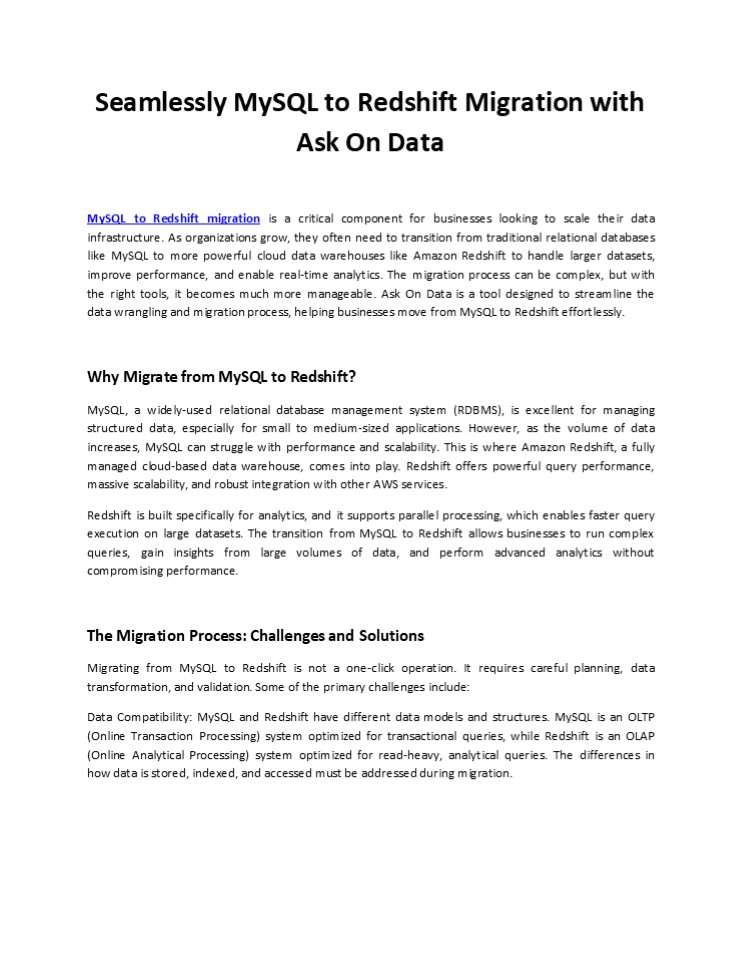Seamlessly MySQL to Redshift Migration with Ask On Data - PowerPoint PPT Presentation
Title:
Seamlessly MySQL to Redshift Migration with Ask On Data
Description:
MySQL to Redshift migration is a critical component for businesses looking to scale their data infrastructure. As organizations grow, they often need to transition from traditional relational databases like MySQL to more powerful cloud data warehouses like Amazon Redshift to handle larger datasets, improve performance, and enable real-time analytics. – PowerPoint PPT presentation
Number of Views:0
Title: Seamlessly MySQL to Redshift Migration with Ask On Data
1
Seamlessly MySQL to Redshift Migration with Ask
On Data
MySQL to Redshift migration is a critical
component for businesses looking to scale their
data infrastructure. As organizations grow, they
often need to transition from traditional
relational databases like MySQL to more powerful
cloud data warehouses like Amazon Redshift to
handle larger datasets, improve performance, and
enable real-time analytics. The migration process
can be complex, but with the right tools, it
becomes much more manageable. Ask On Data is a
tool designed to streamline the data wrangling
and migration process, helping businesses move
from MySQL to Redshift effortlessly.
Why Migrate from MySQL to Redshift? MySQL, a
widely-used relational database management system
(RDBMS), is excellent for managing structured
data, especially for small to medium-sized
applications. However, as the volume of data
increases, MySQL can struggle with performance
and scalability. This is where Amazon Redshift, a
fully managed cloud-based data warehouse, comes
into play. Redshift offers powerful query
performance, massive scalability, and robust
integration with other AWS services. Redshift is
built specifically for analytics, and it supports
parallel processing, which enables faster query
execution on large datasets. The transition from
MySQL to Redshift allows businesses to run
complex queries, gain insights from large
volumes of data, and perform advanced analytics
without compromising performance.
The Migration Process Challenges and
Solutions Migrating from MySQL to Redshift is not
a one-click operation. It requires careful
planning, data transformation, and validation.
Some of the primary challenges include Data
Compatibility MySQL and Redshift have different
data models and structures. MySQL is an OLTP
(Online Transaction Processing) system optimized
for transactional queries, while Redshift is an
OLAP (Online Analytical Processing) system
optimized for read-heavy, analytical queries. The
differences in how data is stored, indexed, and
accessed must be addressed during migration.
2
Data Transformation MySQLs schema may need to
be restructured to fit Redshifts columnar
storage format. Data types and table structures
may also need adjustments, as Redshift uses
specific data types optimized for analytical
workloads. Data Volume Moving large volumes of
data from MySQL to Redshift can take time and
resources. A well-thought-out migration strategy
is essential to minimize downtime and ensure the
integrity of the data. Testing and Validation
Post-migration, it is crucial to test and
validate the data to ensure everything is
accurately transferred, and the queries in
Redshift return the expected results.
How Ask On Data Eases the Migration Process Ask
On Data is a powerful tool designed to assist
with data wrangling and migration tasks. The tool
simplifies the complex process of transitioning
from MySQL to Redshift by offering several key
features Data Preparation and Wrangling Before
migration, data often needs cleaning and
transformation. Ask On Data makes it easy to
prepare your data by handling missing values,
eliminating duplicates, and ensuring consistency
across datasets. It also provides automated data
profiling to ensure data quality before
migration. Schema Mapping and Transformation
Ask On Data supports schema mapping, helping you
seamlessly convert MySQL schemas into
Redshift-compatible structures. The tool
automatically maps data types, handles column
transformations, and generates the necessary
scripts to create tables in Redshift. Efficient
Data Loading Ask On Data simplifies the process
of transferring large volumes of data from MySQL
to Redshift. With support for bulk data loading
and parallel processing, the tool ensures that
the migration happens swiftly with minimal
impact on production systems. Error Handling and
Monitoring Migration can be prone to errors,
especially when dealing with large datasets. Ask
On Data offers built-in error handling and
monitoring features to track the progress of the
migration and troubleshoot any issues that
arise. Post-Migration Validation Once the
migration is complete, Ask On Data helps validate
the data by comparing the original data in MySQL
with the migrated data in Redshift. It ensures
that data integrity is maintained and that all
queries return accurate results.
Conclusion Migrating from MySQL to Redshift can
significantly improve the performance and
scalability of your data infrastructure. While
the migration process can be complex, tools like
Ask On Data can simplify it by automating many
of the steps involved. From data wrangling to
schema transformation and data
3
validation, Ask On Data provides a comprehensive
solution for seamless migration. By leveraging
this tool, businesses can focus on analyzing
their data, rather than getting bogged down in
the technicalities of migration, ensuring a
smooth and efficient transition to Redshift.































